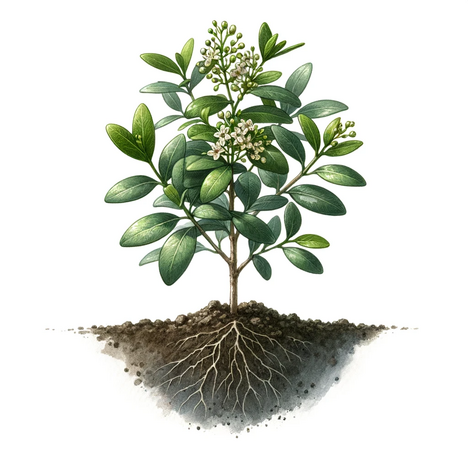Common privet

The garden is a place of relaxation and enjoyment, both for you and your four-legged friend. But there are also unseen dangers lurking here that can be your dog's undoing. One of these potential dangers is the common privet. In this article, you will learn everything you need to know about this plant, its properties and, above all, whether it is poisonous to your dog or not.
What is common privet?
The common privet (Ligustrum vulgare) is a widespread shrub that is often found in hedges and gardens. With its dense, green leaves and small, white flowers that develop into dark berries in summer, it is a popular choice for landscaping. Privet belongs to the olive family (Oleaceae) and is known for its robustness and ability to grow quickly and densely.
Characteristics of the common privet
- Growth habit: Dense, branched shrub that can grow up to 4 meters high.
- Leaves: Oppositely arranged, oval to lanceolate, with entire margins and dark green.
- Flowers: Small, white flowers in upright panicles that bloom in June and July.
- Fruits: Black, shiny berries that ripen in the fall and often remain on the shrub until winter.
Is common privet poisonous to dogs?
Yes, the common privet is poisonous to dogs. All parts of the plant contain toxins, with the leaves and berries being particularly dangerous. The main toxins are ligustrine and ligustron, alkaloids that can cause various symptoms of poisoning in dogs.
Symptoms of privet poisoning in dogs
If your dog has eaten parts of the privet, the following symptoms may occur:
- Vomiting and diarrhea: These are common signs of mild poisoning.
- Abdominal pain: Your dog may behave restlessly and assume a hunched posture.
- Salivation: Increased salivation may indicate irritation of the mucous membranes.
- Weakness and trembling: In more severe cases, your dog may become weak, tremble or even have seizures.
- Cardiovascular problems: In extreme cases, cardiac arrhythmias and circulatory failure may occur.
What to do in an emergency?
If you suspect that your dog has eaten parts of the ligustrum, you should consult a vet immediately. Try to give as much information as possible about the amount ingested and the time of ingestion to enable quick and targeted treatment.
How can I protect my dog from privet?
Prevention is the best protection. Here are some tips on how to protect your dog from common privet poisoning:
- Avoid privet in your yard: If you have a dog, you should refrain from planting privet in your garden.
- Watch your dog: Be vigilant when walking your dog in areas where privet grows.
- Education: Teach your dog not to eat plants that he finds outside.
- Secure the garden: If you already have privet in your garden, make sure your dog doesn't have access to it.
The common privet may be an attractive and low-maintenance plant for the garden, but it poses a serious danger to dogs. All parts of the plant are poisonous and can cause severe poisoning if ingested. It is important that you are aware of this danger and take appropriate precautions to protect your four-legged friend.
If you notice any signs of hypersensitivity or poisoning in your dog, you should see your vet immediately. We are not a substitute for a vet, but we try to be as accurate as possible. Every dog reacts differently and we recommend you get a second opinion or consult your vet if in doubt.
Stay healthy and take good care of your four-legged friend!😊